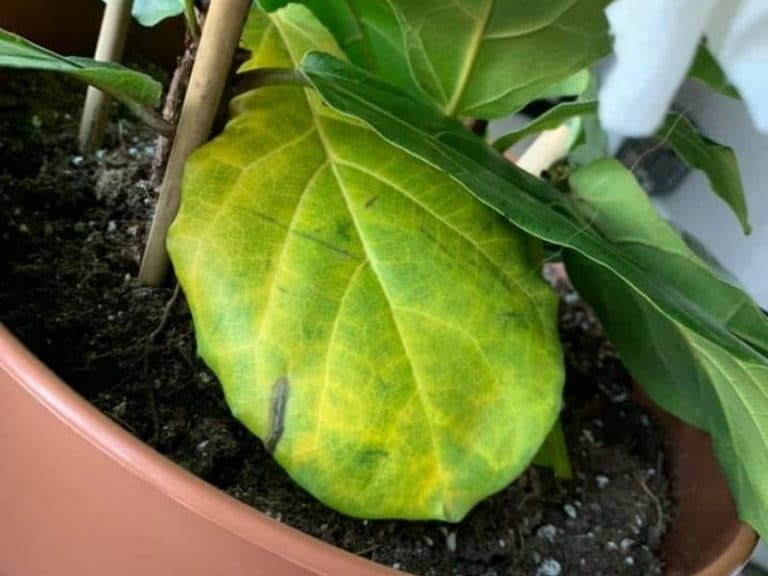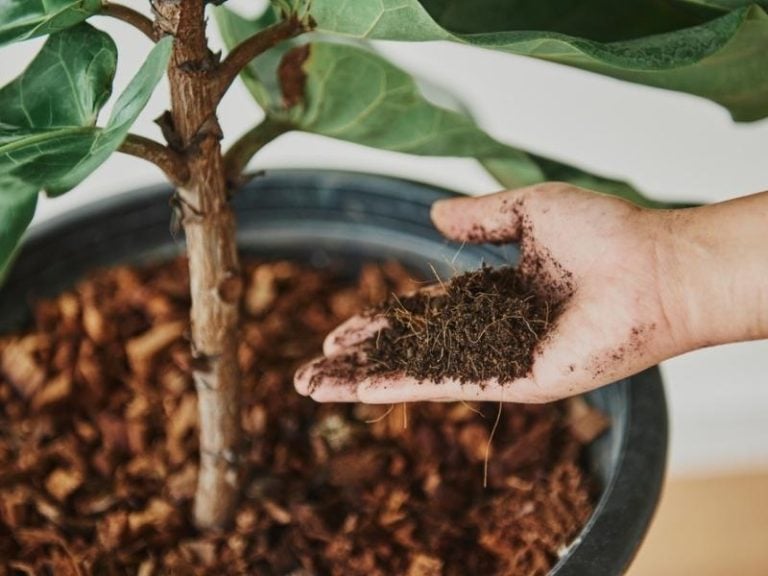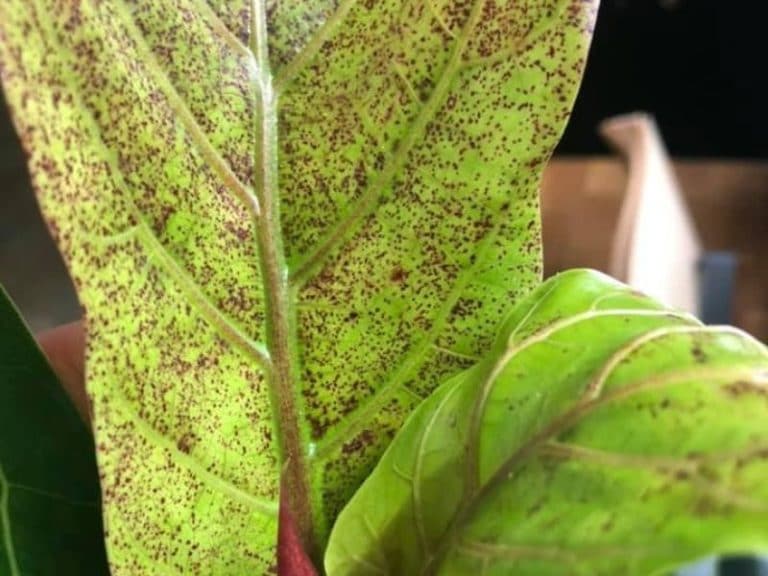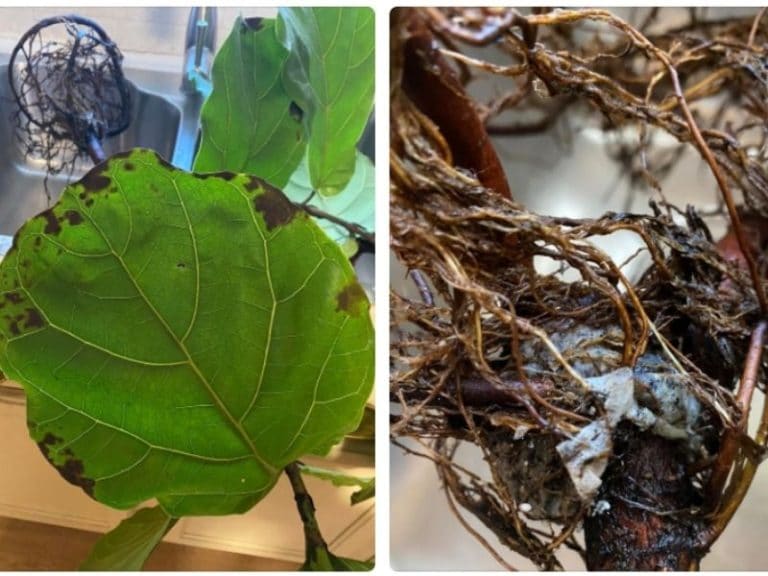How to Get Rid of White Spots on Fiddle Leaf Figs
You don’t expect your fiddle fig (Ficus lyrata) to have white spots on the leaves, do you? If and when they occur, they signal something is wrong with the plant.
While not common, white spots on fiddle leaf figs can occur due to poor care practices, an infection, or pests like mealybugs, whiteflies, and aphids.
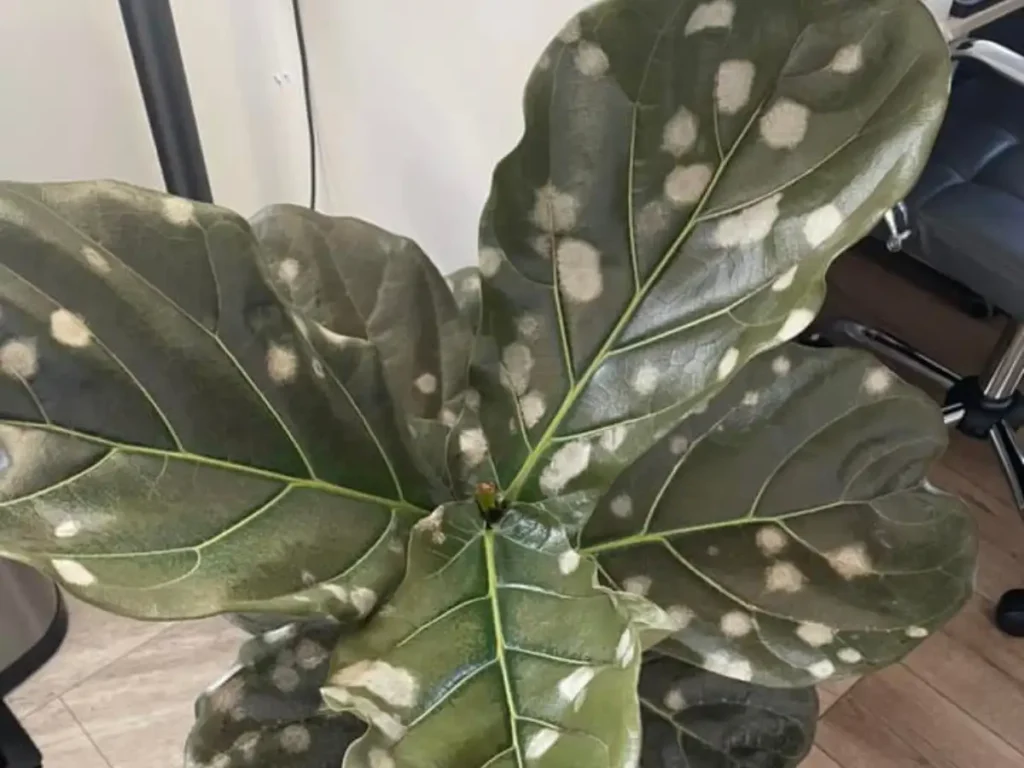
Without identifying the real cause, applying a fix blindly can harm your plant even further. I’m a master gardener, and in this article, I’ll help you troubleshoot your fiddle leaf fig and treat the white spots.
What causes white spots on fiddle figs?
Powdery mildew
Greyish-white spots on fiddle figs can be a sign of powdery mildew, a fungus that grows on the leaf surface.
An infestation leads to powdery spots or patches on the leaves and stems. Under a magnifying glass, this disease appears as a web-like fungal growth on the leaf’s surface.
Those are usually the spores sending their thread-like ‘roots’ into the leaves to get nutrients.
Powdery mildew is prevalent in warm, humid conditions with poor air circulation. The fungus feeds on the plant’s tissues, causing yellowing leaves, stunted growth, and white spots.
Treatment
1. Baking soda
My go-to treatment for powdery mildew is baking soda. This household ingredient kills fungi by raising the pH, making it difficult for them to thrive.
To make a baking soda spray:
Mix 1 teaspoon baking soda and ½ teaspoon of horticultural oil into 1 quart of water. Shake well and strain before spraying onto infected leaves. Reapply every 7-10 days.
If you don’t have horticultural oil, use non-detergent soap. These are great surfactants, helping the baking soda stick to the leaves.
Other effective alternatives to baking soda solution include potassium bicarbonate, a mild vinegar solution, and ethanol-based mouthwash. Each of these options will kill powdery mildew spores upon contact.
2. Apply a sulfur-based fungicide
For severe cases, use fungicidal soap or sulfur-based fungicides following label instructions. Good options include:
- Bonide Sulfur Fungicide.
- Safer Brand Garden Fungicide
I recommend applying fungicides on a dry day to allow the leaves time to absorb the treatment before being misted or rained on (if your plant lives outdoors).
Hard water mineral deposits
Mineral deposits are probably the most common cause of white spots on fiddle leaf figs.
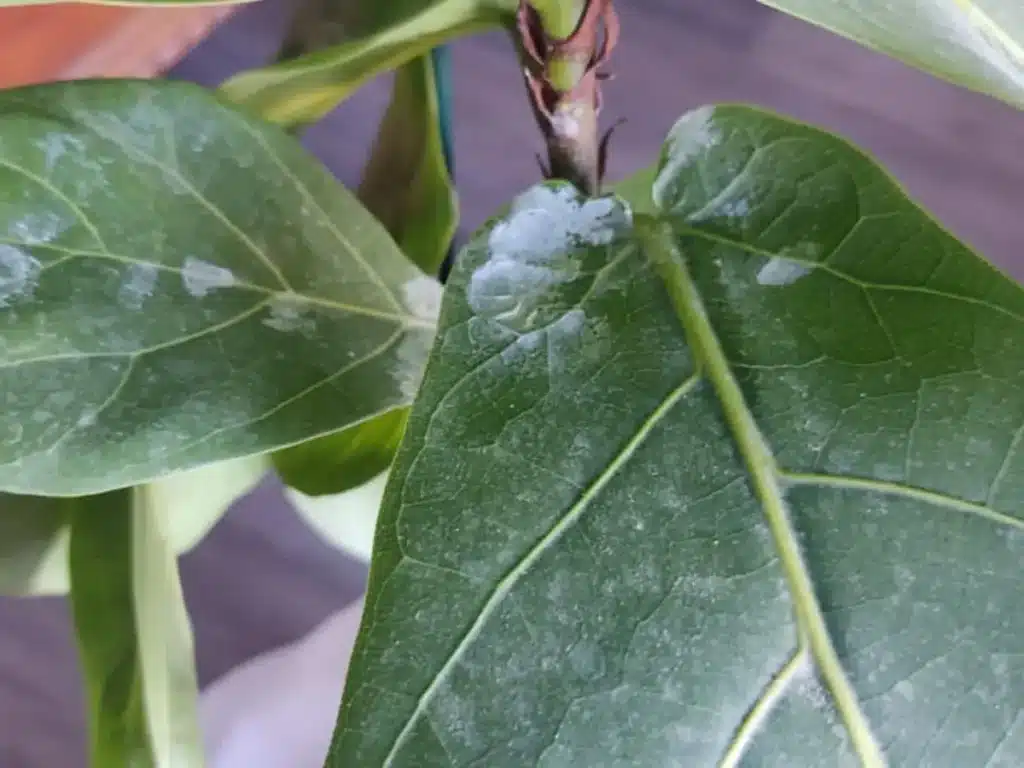
The first thing I do is check for hard water marks on the plant’s leaves, especially if the owner is a beginner. Most first-timers use water from any source to irrigate their plants, a mistake that often leads to issues like this.
Mineral deposits are harmless but leave white dust or flakes on the leaves. They come from minerals like calcium and magnesium in hard water.
You’ll notice the patches after water droplets dry on the foliage. The good news is that these spots wipe off easily with a damp cloth.
How to get rid of the mineral deposits
The solution is as simple as cleaning off the white spots with a soapy solution.
I recommend using a non-detergent soap like Dr. Bronner’s – Pure-Castile Liquid Soap to avoid chemical burns and leaf discoloration.
Here’s how to do it:
- Mix one teaspoon of detergent-free soap with 0.5 gallons of distilled water. Stir the mixture.
- Transfer the solution to a spray bottle.
- Mist the soapy solution all over the spotted leaves and let it sit for 5 minutes to allow the soap to break down the mineral deposits.
- Wipe off the solution and the hard water spots using a microfiber cloth.
Important: Wipe the leaves gently to avoid injuring the leaves or even breaking them.
Preventing mineral deposits
Going forward, prevention is important. Always use distilled or filtered water to irrigate your fig.
In addition, increasing humidity around the plant prevents the water from evaporating too quickly and depositing minerals on the foliage. Light misting or placing a pebble tray with water nearby can help humidify your plants.
Finally, keep the leaves dry with the proper watering technique and air circulation. Aim the water at the soil, not the foliage.
Pest attacks
A variety of tiny-sized bugs that invade fiddle leaf figs may also appear as white spots to the naked eye. The most common of these are mealybugs, which appear as white, cotton-like spots on the leaves.
The white stuff is, in fact, a protective layer of powdery wax that covers the insects’ bodies.
Other possible but unlikely pests causing white spots on fiddle figs include aphids and whiteflies.
- Aphids – Aphids are typically green, but the honeydew they secrete can leave a white residue on foliage. These insects cluster on young shoots, causing curled leaves.
- Whiteflies – If you see white specks flying around your fig, they could be whiteflies.
Pest control options
Upon confirming that the white spots are a result of pest activity, several safe, effective options fix the problem.
Spray insecticidal soap
Insecticidal soap is great at smothering and killing soft-bodied insects like aphids, mealybugs, and whiteflies. The soap disrupts the pests’ waxy outer coating and cell membranes.
Spray it directly on the affected foliage, reapplying every 5-7 days until the infestation clears.
Rubbing alcohol
For isolated pests, I prefer using a cotton swab dipped in 70% rubbing alcohol.
Gently wipe mealybugs, aphids, and scale off stems and leaves. The alcohol kills on contact without harming the plant. It also removes the sticky honeydew.
You can also make a more potent homemade mealybug killer by combining rubbing alcohol and dish soap.
Mix a cupful of 70% rubbing alcohol with a few drops of dish soap and 32 ounces of water. Transfer the solution to a spray bottle and spray the affected fiddle leaf fig leaves to kill the mealybugs.
For maximum efficacy, spray the leaves at least twice a week until you get rid of all the mealybugs.
You can also control mealybug infestations by spraying the fiddle leaf fig foliage with neem oil solution every week or two.
Finally, introducing beneficial insects like lacewings and ladybugs that feed on mealybugs will also help to control the mealybug populations.
Learn more about aphid control using vinegar.
Anthracnose
Another fungal infection, called anthracnose, can also cause white spots on your fiddle leaf fig.
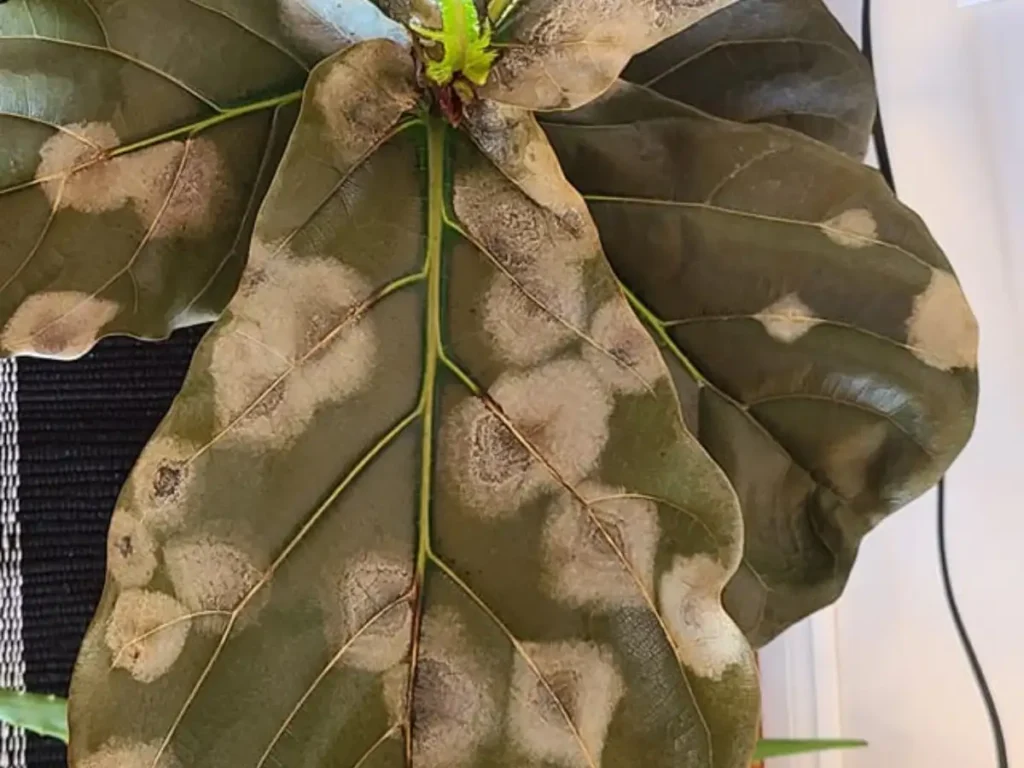
While both anthracnose and powdery mildew can cause white spots, the appearance and progression of the spots is somewhat different and worth noting.
Powdery mildew causes distinct white powdery spots, while anthracnose causes oval-shaped tan/white spots with dark borders that enlarge over time. Affected leaves end up turning brown.
Treatment
The first thing I like to do to get rid of anthracnose is to discourage its spread.
Since the pathogen thrives in wet, shady conditions, move your fig to a bright spot with indirect light. The added sunlight helps dry excess moisture on the leaves.
Next, prune off all infected leaves using sharp, sterilized pruners. Dispose of the leaves with white spots so fungal spores don’t spread. However, avoid cutting off more than 10% of the plant’s foliage at a go.
Finally, treat with a copper-based fungicide to protect healthy leaves and stems. These create a barrier to keep spores from invading.
Further tips:
For stubborn fungal infections causing white patches on fiddle figs, proper care and treatment are required. Try these tips:
- Treat promptly to keep the fungus from spreading.
- Prune off infected leaves and dispose of them to remove the main source of spores. Do not compost infected leaves.
- Increase air circulation around the plant by spacing it out from other plants.
- I also direct fans to blow air over the leaves just to make it harder for spores to settle.
Pro tip: The environmental conditions that favor anthracnose vs. powdery mildew are slightly different. Powdery mildew thrives in warm, humid air with poor circulation while anthracnose prefers humidity but, more specifically, needs wet foliage. If you mist your fiddle figs too often, you risk anthracnose.
Conclusion
When diagnosing the white spots on fiddle leaf figs, think of the kind of water you’re using for irrigation, humidity levels, and potential pests.
You can get rid of the splotches simply by cleaning the leaves with a mild or non-detergent soapy solution, spraying the plant with a baking soda solution or fungicide, or spraying the leaves with horticultural oil.


